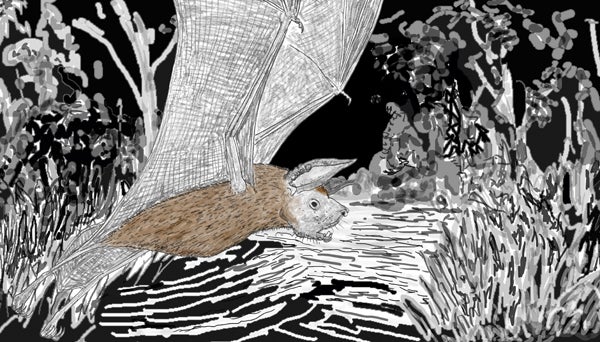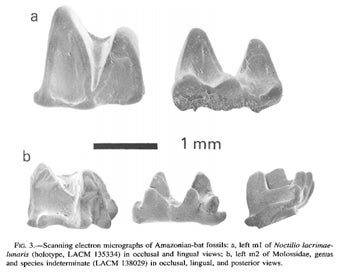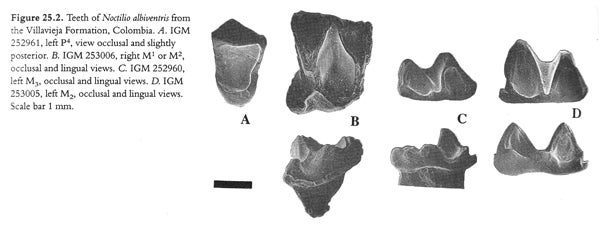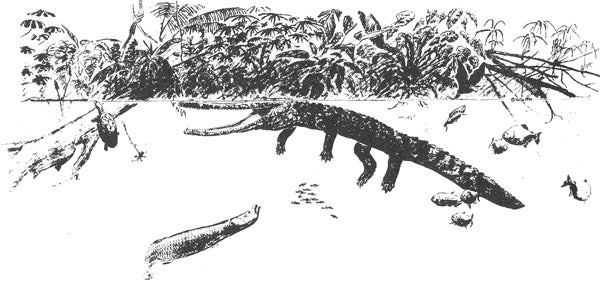This article was published in Scientific American’s former blog network and reflects the views of the author, not necessarily those of Scientific American
The previous article introduced noctilionoids, the enormous Neotropical bat group that includes phyllostomids (Neotropical leaf-nosed bats), mormoopids (naked-backed, moustached or ghost-faced bats) and others. Here, we continue to look at one noctilionoid group among the several: the noctilionids, or bulldog bats. What, specifically, do we know about the fossil record of this group?

A bulldog bat, foraging at night over a South American river. Credit: Darren Naish
Fossil noctilionids are known from several locations, though (as typical with bats) the fossils are fragments and not all that impressive. Least surprising are the Upper Pleistocene and/or Holocene fossils – referred to N. leporinus – from cave deposits on Puerto Rico, Isla de Pinos, Cuba and Antigua. An enormous number of living tetrapod species have fossil records that extend back to the Pleistocene: it is, in fact, generally expected that extant mammal species will be found in sediments from that time. A Middle Pleistocene canine from a Noctilio of indeterminate species is interesting in that it comes from Necochea in Buenos Aires Province, Argentina (Morgan & Czeplewski 2012); an area just outside the modern range of these bats.
On supporting science journalism
If you're enjoying this article, consider supporting our award-winning journalism by subscribing. By purchasing a subscription you are helping to ensure the future of impactful stories about the discoveries and ideas shaping our world today.

The tiny holotype tooth of the extinct Peruvian bulldog bat Noctilio lacrimaelunaris, from Czaplewski (1996). The marvellous species name - meaning ‘tears of the moon’ - refers to a mythical idea about the origin of the Amazon. Credit: Czaplewski 1996
Then there’s an extinct species – N. lacrimaelunaris, named for a single lower molar – from the Upper Miocene of Río Acre, Peru (Czaplewski 1996). This one tooth is smaller than are the lower molar teeth of living noctilionids, so the whole animal itself was presumably somewhat smaller too. Nothing specific is known about its relationship to the other bulldog bat species, and likely won’t be known until more complete remains are known.

These bulldog bat teeth from the Miocene of Colombia, described by Czaplewski (1997), are significant because... they seem to belong to a species that is still with us today. Credit: Czaplewski 1997
But more interesting and surprising than any of these prior records is the identification of teeth pertaining to the extant N. albiventris, yet hailing from the Villavieja Formation of the Río Magdalena Valley, La Venta, Colombia. The sediments here date to the Upper Miocene and are something like 12.5 million years old, yet the teeth concerned are similar enough in anatomy and size to those of N. albiventris that Czaplewski (1997) thought their identification pretty reliable, concluding “It follows that N. albiventris has been evolutionary static since 12.5 Ma” (p. 415). That’s weird, and totally not ‘normal’ for mammals at all (large fossil mammals have durations of between 2.3 to 4.3 million years and small species are generally even shorter-lived; Prothero 2014). We mostly dislike using the term ‘living fossil’ these days – it doesn’t really mean anything useful and is virtually always incorrectly applied – but… the idea that the same modern bat species has been flying around for more than 12 million years sure does make this species seem worthy of that title… assuming, of course, that Czaplewski’s identification is correct. More recent appraisals of the Neoptropical bat fossil record have supported the identification (e.g., Morgan & Czaplewski 2012).

A Miocene scene depicting an aquatic faunal assemblage inhabiting La Venta, Colombia. The duck-faced alligatoroid is extinct whereas the fishes and turtle belong to groups that are still extant. The big surprise is the bulldog bat - visible at upper right, grabbing a fish from the water - since it belongs to a species that’s still with us today. The image is by Nicholas Czaplewski. Credit: Smithsonian Institution Press, Washington and London
So there we have it. As always, there is so much more to say. Noctilionoids (note: not noctilionids) include fossil taxa, not mentioned here, that have further relevance as goes the biogeographical history of this group. And what might an affinity of noctilionoids with Madagascan sucker-footed bats or the Australasian mystacinids mean for bat evolution and history? (Pierson et al. 1986). We will return to these issues in time…
For previous Tet Zoo articles on bats, see...
Introducing the second largest mammalian ‘family’: vesper bats, or vespertilionids
Bent-winged bats: wide ranges, very weird wings (vesper bats part III)
The many, many mouse-eared bats, aka little brown bats, akaMyotisbats (vesper bats part V)
Long-eared bats proper: Plecotus and other plecotins (vesper bats part VI)
Robust jaws and a (sometimes) ‘greenish’ pelt: house bats (vesper bats part IX)
Antrozoins: pallid bats, Van Gelder’s bat, Rhogeessa… Baeodon!! (vesper bats part XI)
Putting the ‘perimyotines’ well away from pips proper (vesper bats part XII)
Eptesicini: the serotines and their relatives (vesper bats part XIV)
Hypsugines: an assemblage of ‘pipistrelle-like non-pipistrelles’ (vesper bats part XV)
Books of the TetZooniverse: of Palaeoart, Bats, Primates and Crocodylians
Fossil Bat Stories, Part 2: What Are Noctilionids? What Are Noctilionoids?
Refs - -
Czaplewski, N. J. 1996. Opossums (Didelphidae) and bats (Noctilionidae and Molossidae) from the Late Miocene of the Amazon Basin. Journal of Mammalogy 77, 84-94.
Czaplewski, N. J. 1997. Chiroptera. In Kay, R. F., Madden, R. H., Cifelli, R. L. & Flynn, J. J. (eds) Vertebrate Paleontology in the Neotropics: The Miocene Fauna of La Venta, Colombia. Smithsonian Institution Press (Washington and London), pp. 410-431.
Morgan, G. S. & Czaplewski, N. J. 2012. Evolutionary history of the Neotropical Chiroptera: the fossil record. In Gunnell, G. F. & Simmons, N. B. (eds) Evolutionary History of Bats: Fossils, Molecules and Morphology. Cambridge University Press (Cambridge), pp. 105-161.
Pierson, E. D., Sarich, V. M., Lowenstein, J. M., Daniel, M. J. & Rainey, W. E. 1986. A molecular link between the bats of New Zealand and South America. Nature 323, 60-63.
Prothero, D. R. 2014. Species longevity in North American fossil mammals. Integrative Zoology 9, 383-393.